Published
on 14
Dec 2015
|
All rights reserved.
|
|
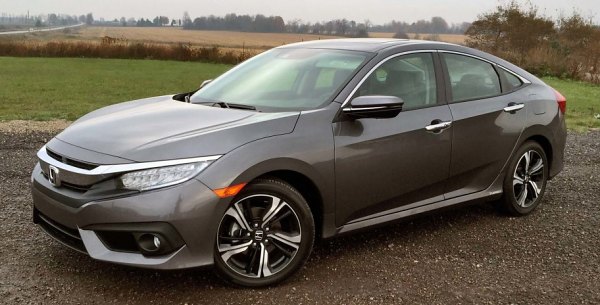 |
|
The
Civic becomes avant-garde again.
|
|
Not many nameplates
in the automotive industry have the luck to celebrate the 10th
generation. Following Toyota Crown and Corolla, Honda Civic is the
third to reach the milestone. For most of the last 43 years, Civic was
reckoned as a forward-thinking and sporty-driving small car, a sharp
contrast
to arch-rival Corolla. In recent years, however, it became more
conservative. The 9th generation Civic received only 3 stars in
AutoZine rating, blame to its modest engines, numb steering and
unremarkable styling. Favouring comfort more than driving pleasure, it
was no longer the Civic we used to know.
Thanks to pendulum effect, the 10th generation Civic becomes
avant-garde again. Look at these pictures! Its styling is a lot sharper
and sportier! The angular design at nose and tail is so aggressive!
Moreover, its body shape is finally right. One thing we didn’t like the
last 2 generations was their wedge front, which gave a perception of
minivan rather than Lamborghini. The new car gets not only a proper
front but also pronounced flanks like classic sports cars, which makes
it unusual among small family cars. Furthermore, its fastback shape
looks a lot sleeker than the old car. Our only worry is whether the
aggressive nose and tail withstand the test of time. For sure it won’t
last as long as a Volkswagen Golf, but then the Civic’s lifecycle is
relatively short at 4.5 to 5 years.
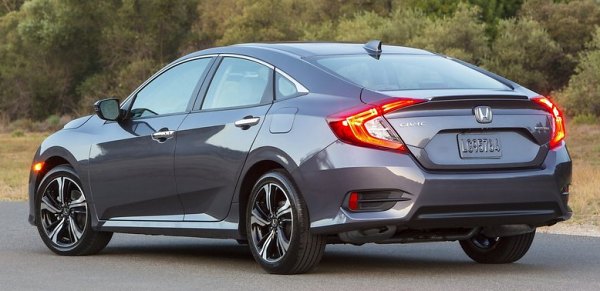 |
|
The
fact that it becomes more American-size than ever is not coincident,
because its development is actually led by Honda America.
|
|
The new Civic also looks considerably larger than the old car, more
like halfway between the old car and an Acura TSX. It is. Because it is
now sitting on a platform that will be shared with the next generation
Accord, it
is able to stretch its length by 125 mm, width by 43 mm and wheelbase
by 30 mm. The latter is now a class-leading 2700 mm. Admittedly, the
sense of size is also exaggerated by its lower roof line, which drops
by 20 mm. According to Honda, the extra dimensions created 91 liters
of extra space in the cabin and 76 liters of luggage space. Rear
passengers are benefited with 50 mm more legroom, and don’t forget the
old car was already quite generous in this respect! The fact that it
becomes
more American-size than ever is not coincident, because its development
is actually led by Honda America.
Inside, apart from more space, two things mark a big difference from
the old car. The first is a more expansive forward visibility, thanks
to a 40 mm lower windscreen cowl (base of windscreen) and thinner
A-pillars, a result of abandoning the monospace design. The driver now
sits 25 mm lower in the cabin yet can have a clearer view of the road
ahead. Another is the dashboard design, which finally abandons the
ergonomically unfriendly 2-tier structure that drew a lot of criticisms
in the past 10 years. However, its ergonomics is still not perfect,
because you have to use the 7-inch touchscreen to do simple things such
as adjusting audio volume, which isn’t as easy to do as a rotary knob
when the car is moving. On cheaper trims the Civic does offer such
knobs, but then its screen is only 5-inch. As for build quality and
materials, the new car gets a predictable upgrade, but the center
console and transmission tunnel still look cheap. The angular and busy
interior design does not help perception of quality, too.
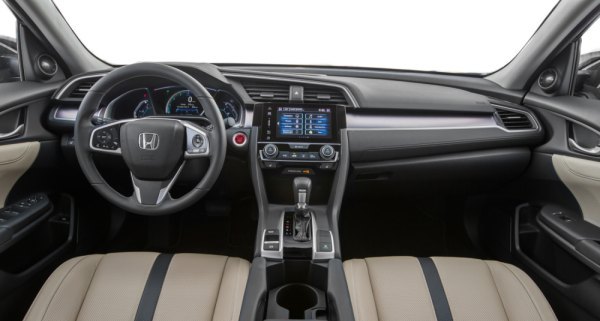 |
|
The
dashboard design finally abandons the ergonomically unfriendly 2-tier
structure that drew a lot of criticisms in the past 10 years.
|
|
Like the rest of the industry, the new Civic employs higher percentage
of high-strength steel (up from 55 to 59 percent) and
ultra-high-strength steel (up from merely 1 to 14 percent). This lifted
its torsional rigidity by 23 percent yet lightening the monocoque body
by 31 kg. The whole car is lighter by about the same amount. Thanks to
more sophsticated crumple zone structure, the car can have a shorter
front overhang to provide better impact absorption. This means most of
its added length can be spent to the tail to increase luggage space.
The aerodynamics is also improved. Total drag (CdA) is reduced by 15
percent, thanks in part to full underbody covers.
Suspensions remain to be struts at the front and multi-link at the
rear, but they are heavily redesigned. The rear suspensions are now
mounted on a very rigid sub-frame. Hydraulic bushings are adopted to
improved ride comfort. Enhanced sealings and flush-mounted windscreen
reduce cabin noise.
Under the bonnet, the base engine becomes a larger, 2.0-liter DOHC
i-VTEC with 158 horsepower, 15 hp stronger than the old car’s 1.8 SOHC.
It is a willing motor, providing old-school fun especially when it is
mated with 6-speed manual. The latter’s gearchange might not be as
slick and short as the best Honda manual boxes, but it is far more
engaging than the alternative CVT. 0-60 mph can be accomplished in a
brisk 8.0 seconds, which is very good for an affordable small family
car. Civic drivers can be proud again.
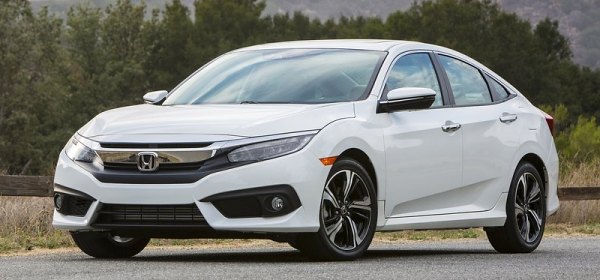 |
|
Some
of its traditional lightness and agility have returned...
|
|
Unexpectedly, the premium engine is “Earth Dream” 1.5 i-VTEC
direct-injection turbo. Honda’s first small turbo engine produces a
respectable 174 horsepower and 162 lbft of torque from 1800 to 5500
rpm. It gives the Civic a stronger mid-range punch for overtaking and a
more relaxed manner at urban speed. However, it displays a hint more
turbo lag at low revs than the best European small turbo motors, say,
Ford 1.5 Ecoboost or Volkswagen 1.4 TSI. Moreover, the compulsory CVT
it employs tends to drone the engine unpleasantly under hard
acceleration, which amplifies the turbocharged engine’s coarse exhaust
note. Furthermore, the CVT lacks manual override thus you can’t dictate
its behavior.
On the road, the new Civic demonstrates improved refinement and comfort
through its effective sound insulation, solid chassis and compliant
ride. Meanwhile, some of its traditional lightness and agility have
returned. It has body roll well checked. The nose turns in quickly, and
understeer is well suppressed. The new variable-ratio electrical power
steering reacts much faster than the old one, with lock-to-lock reduced
from 3.1 to merely 2.2 turns. That said, despite of its dual-pinion
design, the steering still lacks true communication. On the straight
ahead position it is virtually muted, not giving the driver any sense
of engagement. This prevents it from threatening Mazda 3 or Ford Focus
for handling. However, its stronger sense of space, comfort and
refinement could give it an advantage in the eyes of most family car
buyers. More important, this 10th generation does not alienate the fans
of Civic anymore. It returns to the right track finally.
|
Verdict:     |
| Published
on 7
Mar 2016 |
All rights reserved.
|
|
Civic Coupe
|
|
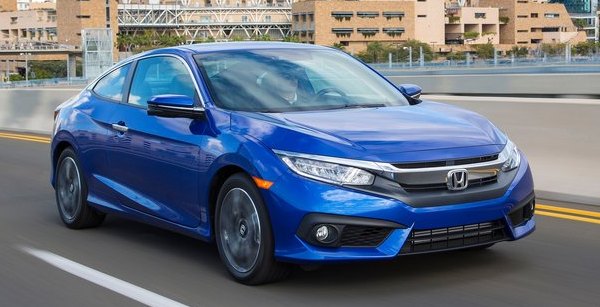 |
|
The
Civic Coupe is affordable, practical and accommodative, if not very
interesting to drive.
|
|
Sedan-based
affordable coupe is a dying breed. USA is the only place buying such
cars in large quantity, yet that market is also shrinking quickly.
Detroit manufacturers have abandoned it altogether – do you remember
just a decade or two ago they were still producing Ford Escort ZX2,
Dodge Neon R/T Coupe, Saturn SC, Ion Quad Coupe and Chevy Cobalt Coupe?
Now their smart money turns to build small SUV crossovers. Ditto Ford
Europe (which killed Puma), Opel
(Astra Coupe), Renault (Megane Coupe), Mini (Mini Coupe), Hyundai
(Tiburon and Elantra Coupe) and Toyota (Levin, Celica and the latest
casualty, Scion tC). Today, only 2 cars survive in the segment, i.e.
Kia Forte Koup and
Honda Civic Coupe. I am quite surprised that Honda is still investing
into a new generation Civic coupe despite of the dim prospect.
The new 2-door Civic does not deviate from the established formula. It
is affordable, practical and accommodative (for a coupe). Although it
shares exactly the same front end with the Civic sedan, its sloping
fastback looks more handsome. While the last generation looked like a
pig, it looks far more athletic, being sleeker, lower and wider. Sharp
crease lines and angular lights demonstrate an aggressive character not
found in any previous Civics.
Meanwhile, the interior is surprisingly light and airy, unlike many
modern coupes, thanks to relatively large windows. The swoopy fastback
does not rob a lot of headroom, leaving enough space for sub-6-footers.
Rear legroom is also aplenty, thanks to the fact that it keeps the
sedan’s
2700 mm wheelbase. Up front, the driver enjoys a supportive front seat.
The dashboard design and sense of quality is disappointing, as in the
Civic 4-door. However, there are plenty of kits and safety features.
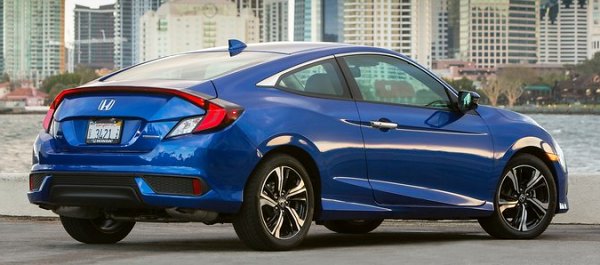 |
|
While
the last generation looked like a pig, it looks far more athletic...
|
|
Predictably, the coupe employs the same powertrains as the sedan, i.e.
158 hp 2.0 i-VTEC mated with 6-speed manual or 175 hp 1.5 i-VTEC Turbo
paired with CVT. Although the latter’s thicker torque hence stronger
performance and flexibility is appreciated, the rubber-band effect of
CVT robs it of ultimate driving pleasure. This means, enthusiastic
drivers should stick with the cheaper powertrain, which revs higher,
responds quicker to throttle and sings with a satisfying mechanical
noise, just as a good fast Civic should. Its manual gearbox comes with
a light clutch, slick and crisped gearshift, a sharp contrast to the
uninspiring CVT. The base Civic coupe needs almost 8 seconds to sprint
from 0-60 mph, not exactly a hot coupe, but then it is not supposed to
be an Si or Type R. As a more personal-oriented alternative to Civic
sedan, its mechanical package is well judged.
Apart from performance, the ride and handling is also similar to the
Civic 4-door, which is not a shame considering how much the latest
generation has improved upon the last one. First of all, its chassis is
a lot stiffer, and insulation is much enhanced. Some models even get
hydraulic bushings at rear suspensions. The result is a very refined
ride, like Volkswagen Golf. The suspension setup is said to be stiffer
than the sedan, but the difference is not obvious. This means it is
still slightly biased towards the comfort side. Nevertheless, the
handling is by no means poor. The 2.2-turn steering is quick enough to
inspire excitement, although its average feedback isn’t. The body
control, roadholding and braking are up to the task, if not as good as
a European hot hatch. At the limit, the Civic coupe understeers, just
like its sedan sibling. Mind you, keen drivers should be better served
by a proper hot hatch or the forthcoming Type R coupe. However, if you
want the coupe look without sacrificing the comfort, convenience and
value for money of the Civic sedan, this one is perfect for you.
|
Verdict:    |
Published
on 10
Feb 2017
|
All rights reserved.
|
|
Civic Hatchback
|
|
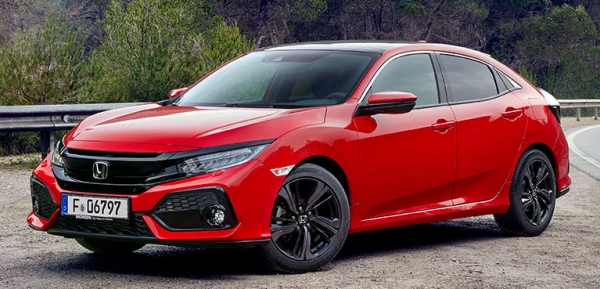
|
|
Returning
to the roots, the Civic Hatchback is a sizeable improvement.
|
|
In its hey days,
Honda Civic was my favourite Japanese compact family cars. It was
renowned for low-slung sports car styling, revvy engines, good
performance and all-double wishbone suspensions. If not ultimately the
best driver’s car, it was at least a great basis for modifications.
Things started went wrong as the car entered the new millennium. Honda
suddenly felt the need to differentiate the Civic to suit different
markets. As a result, the Japanese and American Civic became more
conservative and comfort-oriented sedans; The European Civic became
luggage-oriented hatchbacks. They parted ways so much that no longer
shared a lot of genes. Yes, the last two generations European Civic
shared few parts with its JDM and US cousins. They switched to a
completely different architecture with the fuel tank located under the
front seats, elevated the hip points together with waist line, the roof
and also the center of gravity. This led to a very unfortunate shape,
too.
The relocation of fuel tank was part of the effort to enable the rear
seat to flip up and store tall luggage. For the same purpose,
independent rear suspensions were dropped in favour of simple torsion
beam. Its interior designers also went too far to create a double-tier
dashboard, which was ergonomically challenging. If not the last, very
fast Type R Turbo saved the game, the outgoing European Civic would
have left us only regrets.
Happily, the days of regret are over. Although globalization suddenly
sounds strange in the rise of Donald Trump, Honda realizes the need for
globalization and reunites the regional Civics again. Now the European
Civic – while still being assembled in UK – is practically the
hatchback conversion of the Civic sedan sold in North America. In fact,
from its looks you can already tell that.
This change also allows the hatchback to be built and sold in North
America, so it is a world car again.
With very edgy front and rear design, the Civic hatchback is not easy
to please eyes. However, like the sedan, its fast-angle back, low and
flowing waist line bring a strong sporty flavour. Vast fake vents at
both ends and centrally-mounted exhaust add further aggression. It
looks so aggressive that I suppose the next Type R needs no more than a
huge rear wing and larger wheels for exterior enhancement. Since it
shares floorpan with the sedan, its wheelbase is a class-leading 2700mm
or nearly 100mm up from the old car! The front and rear overhangs are
obviously longer, too, so the overall length gains 233 mm to 4518 mm.
This is an American-sized hatchback! The car also gets 30mm broader,
but its roof is lowered by nearly 40mm thanks to abandoning the
aforementioned fuel tank and luggage arrangement. In other words, it
becomes conventional again, with the fuel tank located under the rear
seat and seating levels much closer to the floor. Although the cabin
loses luggage space, the boot space is class-leading at 478 liters,
thanks to the long overhang.
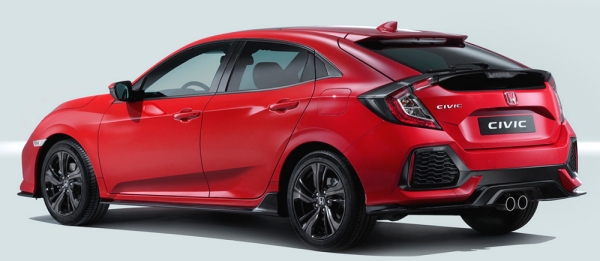
|
|
Punchy
Earth Dream engines are matched with good chassis dynamics.
|
|
Inside, driver’s headroom is improved as you sit 34mm lower. Rear
headroom is still slightly limited by the sloping fastback though, but
the extended wheelbase offers plenty of legroom. The dashboard and
pretty much all the interior packaging follows the American Civic. This
means a conventional dashboard and instrument layout, improved build
quality but the plastics and switches are not quite as good as the best
European rivals. Outward visibility is good up front but less so at the
back, blame to the fake rear quarter windows (they are too small
anyway).
Like its American sibling, it employs the new Earth Dream 1.5-liter
direct-injection turbo engine. Although it is dubbed a VTEC, it
actually uses
VTC cam phasing on both camshafts rather than the traditional
cam-changing VTEC. Power output is a bit higher than the American
version at 182 hp and 177 lbft of torque. When mated with Honda’s
short-throw, slick-shifting 6-speed manual gearbox, it offers
remarkable
performance: 0-60 mph takes only 7.7 seconds, while the car will flat
out at 137 mph. The motor combines a gusty mid-range with good
refinement. For a mainstream engine, it is quite impressive. Another
engine also comes from the Earth Dream family. It is the new
entry-level 1.0-liter direct-injection 3-cylinder turbo. Equipped with
both VTC and intake VTEC, its specific power is even higher than the
four-pot, with 129 hp and 147 lbft of torque on offer. Apart from the
new Ford 1.0 Ecoboost 140hp, this should be the most powerful 1-liter
engine on the market. Unfortunately, it suffers from more turbo lag
than the 1.5-liter, and it redlines at only 5600 rpm, so you get a
useable power band of less than 3000 rpm.
Compared with the old hatchback, the new one has a much improved
chassis, not least of which is the return of multi-link rear
suspension. In top trim, it is even offered with electronic
adaptive dampers. Meanwhile, the new monocoque chassis is 52 percent
stiffer torsionally than the old one while trimming 16kg of weight. The
center of gravity drops by 10mm. In addition to the wider tracks and
longer wheelbase, handling and ride quality are both improved. It rides
smoothly on normal roads and feels absorbent enough on B-roads. Grip,
balance and body control are
decent. The steering is quick and consistently weighted, if not very
feelsome. As in the case of Civic sedan, the hatchback is not as sharp
or as agile as Mazda 3, Ford Focus, Opel Astra or Seat Leon, nor it is
as quiet as Volkswagen Golf, but its dynamics are above class average,
while ride comfort is one of the best. Such an all-round manner puts
the new Civic hatchback back to the shortlist of small family car
buyers.
|
Verdict:     |
Published
on 5
Jun 2017
|
All rights reserved.
|
|
Civic Si
|
|
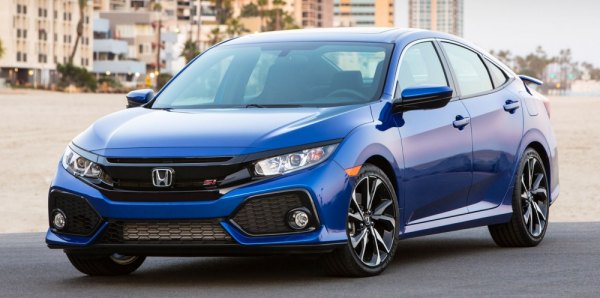
|
|
Good
chassis let down by a characterless engine.
|
|
As before, Civic Si is the
last stop before the ultimate Type R. It is offered in both sedan and
coupe form to attract wider audiences. Both cars are built in Canada
and
supplies only the North America market. Over there, its main rivals are
Volkswagen
Golf GTi and Ford Focus ST, both are good cars but have been around for
several years. The new Civic Si based on the 10th generation Civic is
much fresher, of course. Benefited with a sharper look, long-wheelbase
chassis and new multi-link rear axle (finally matching its rivals), can
it teach VW and blue oval a lesson? We shall see.
Since 1992, the Civic Si had been using high-revving VTEC engine and a
slick manual gearbox. This winning combo gave its drivers immense fun.
However, the new Si finally breaks away from this tradition, turning to
a downsized turbocharged motor. It is based on the 1.5-liter Earth
Dream direct injection turbo four-cylinder that serves the lesser
Civics. A larger turbo lifts boost pressure from 1.14 bar to 1.4 bar,
which is very high indeed – for comparison, even a car as hot as AMG GT
R uses only 1.35 bar. Accompanied with high-flow intake and exhaust,
the small motor produces 205 horsepower, equaling the old car’s
2.4-liter VTEC. Predictably, its torque output eclipses the latter
easily – some 192 pound-foot is available from 2100 to 5000 rpm,
compared with 174 lbft at 4400 rpm. The result? You can always keep the
engine running at 3000 rpm on highway. You are no longer required to
make gearshift as often, which is a pity considering how sweet the
gearshift is.
As the new car weighs virtually the same as last gen, we expect it to
be slightly quicker to go from 0 to 60, or in the low 6-seconds range.
However, when it comes to excitement, the new turbo motor has to settle
in second place. While the 2.4 VTEC begged you to rev to 7000 rpm and
rewarded you with corresponding sound (the older 2.0 VTEC was even good
for nearly 8000 rpm), the 1.5 Turbo has its horsepower peaked at merely
5700 rpm, and asks you to upshift before 6000 rpm, otherwise you will
see its power drop off quickly. This makes its 6500 rpm redline
superfluous. Moreover, its exhaust note sounds dull and muted, failing
to live up to the expectation for a hot hatch. Yes, the new engine
offers more flexible power thus is probably the quicker car by a
whisker, but what is the benefit if performance comes at the expense of
thrills?
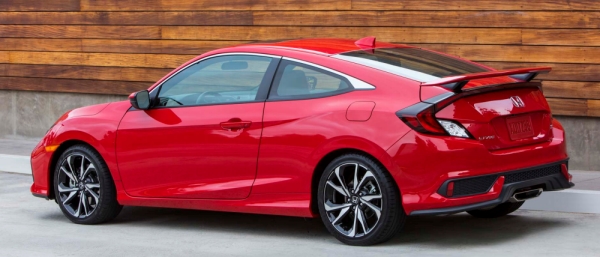
|
|
While
the old VTEC begged you to rev to 7000 rpm, the new turbo asks you to
upshift before 6000...
|
|
Comparatively, changes made to the chassis are more successful. The
suspension gets stiffer springs, anti-roll bars and bushings, while
adaptive dampers are adopted for the first time. The latter is linked
to a 2-mode drive control which also alters throttle response and
steering effort. The steering itself is a variable-ratio dual-pinion
electric rack. It takes just 2.1 turns to go from lock to lock, giving
the new car an extra sense of agility. The front suspension employs the
stiffer upper control arms from Type R, which also helps the steering
to deliver clearer information from the contact patches. In addition to
larger front brakes, 235/40R18 tires and standard helical LSD, the Si
corners with good body control, traction and grip. It understeers
gently at the limit, and the overall handling is predictable, if not
very playful. Ride
quality is generally composed in normal mode, although sport mode is
far
from harsh.
Problem is, the 1.5 turbo engine lacks sparkles and character, not just
compared with the old VTEC but also the larger, 2.0-liter turbo of its
rivals. Facing the latter, its
performance sounds a bit tamed as well. No wonder Honda declines to
sell it in Europe, where there are countless of affordable hot hatches.
|
Verdict:    |
Published
on 16
Jun 2017
|
All rights reserved.
|
|
Civic Type R (FK8)
|
|
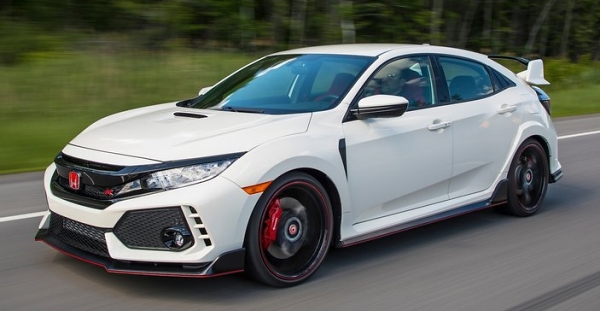
|
|
The
last Civic Type R had a life cut short, but many of its goodies live
again on the new car, whereas its vices are all but banished.
|
|
The last generation Civic
Type R, codenamed FK2, was a fast and exciting super-hot hatch that
came close to match the class-leading Renault Megane RS275 and
Volkswagen Golf R. It was also once the fastest hot hatch and
front-wheel-drive car lapping Nurburgring Nordschleife (at 7:50.6).
However, built on the odd Civic hatchback platform of the time, it was
compromised in many areas. Its fuel tank was placed underneath the
front seats, raising the seating position as well as the car’s overall
height and center of gravity. It used a torsion-beam rear axle instead
of independent multi-link setup of some rivals. It had a fat wedge
proportion that only its mother would love. Its double-decker dashboard
was a nightmare of ergonomics. Worse still, it was not in the original
development plan of the Civic, so it came late in the latter’s
lifecycle and survived for only 2 years. Nevertheless, many of its
performance elements are still state of the art, especially its VTEC
turbo engine and its aerodynamics. No wonder they have been recycled
for use in the new generation, codenamed FK8. Unlike its predecessor,
the new Type R was put into the product plan from the outset, so it can
be launched just months after the European Civic hatchback. As before
it is assembled exclusively in the Swindon plant in UK (together with
the Civic hatchback, of course), but this time it will be sold in the
USA and Japan as well as Europe, so this is the first ever global Civic
Type
R.
The styling of the new car is still over-the-top, with massive skirts,
wings, scoops and fender extensions in angular treatment. However, the
car’s proportion is finally right, being lower, longer, wider and
sleeker. The Civic’s 2700mm wheelbase is a massive 100mm longer than
last gen’s, while its roof is lowered by 32mm. The base of the
windscreen is also significantly lowered. Some might be put off by the
car’s exaggerating dressing and prefer the purist approach of, say, the
late Megane RS or Opel Astra OPC, but others might like the idea of a
pseudo Group B rally special.
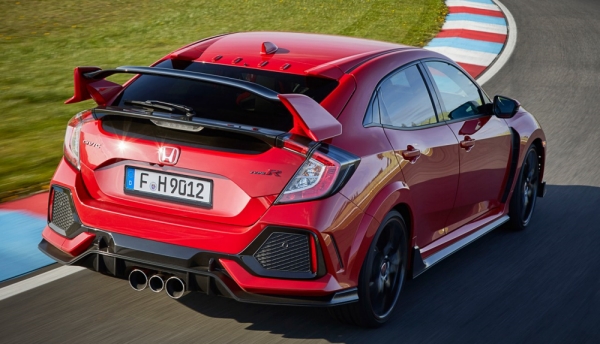
|
|
Some
might be put off by its exaggerating dressing, but others might like
the idea of a pseudo Group B rally special.
|
|
The FK8 is not born for rallying, of course. It is designed for
high-speed road course, where its aerodynamics shows superiority over
any other hot hatches. With an unlimited top speed of 169 mph, this is
easily the fastest car in its class, unless you count also the mad,
400hp Audi RS3 Sportback as its rival. The Civic loses as much as 80
horsepower to the RS3 yet its top speed is only 5 mph lower. This shows
how good its aerodynamics is. It is not all about low drag either. In
fact, Honda claims it is the only hot hatch that produces positive
downforce – something you won’t doubt from its massive rear wing and
front splitter. (BTW, the claim is actually wrong, as Volkswagen
declared its Golf Clubsport and Clubsport S produce a slight positive
downforce). Compared with the old car, it generates 3% less drag and
slightly more downforce. Helps come from the small fins on roof, flat
underbody and “air curtain” design around its wheels.
Improvement to the chassis is equally obvious. Thanks to the new basis,
its body shell is 38 percent stronger in torsional rigidity and center
of gravity is lowered by a significant 34mm. The new multi-link rear
axle improves ride quality as well as stability under braking. Up
front, it carries over the dual-axis struts of the old car, which cuts
torque steer by reducing king pin offset (like Renault's PerfoHub,
Ford's RevoKnuckle or Opel’s HiPer strut), but the lower control arms
and knuckles are now made of aluminum to cut unsprung weight. The
adaptive dampers have been upgraded to a 3-chamber design to offer a
wider range of adjustment. The Continental SportContact 6 tires get
10mm wider, and they are shod over larger 20-inch wheels. This makes
the unchanged Brembo brakes look small, although they are not – 350mm
cross-drilled ventilated discs with 4-pot calipers up front, 305mm
solid discs
with single-piston calipers at the rear. The dual-pinion electrical
power steering gets a variable ratio-rack (not active,
fortunately) which needs only 2.1 turns from lock to lock.

|
|
Engine
is largely carried over; Driving position is finally spot-on.
|
|
The turbocharged 2.0-liter VTEC direct injection motor is largely
carried over. As before, it gets some serious components such as
sodium-filled exhaust valves, piston-cooling oil jets, forged steel
crankshaft, forged con-rods, dual-variable cam phasing (VTC) and
variable exhaust valve lift (VTEC) – the latter is used to increase air
flow at low rpm thus helps spooling up the turbo quicker. Maximum turbo
boost is remarkably high at 1.6 bar! No wonder it pumps out 320
horsepower at 6500 rpm (US-spec only 306hp), 10 ponies more than
before. The extra juice is contributed mainly by a freer flowing
exhaust and remapped ECU. As before, the motor redlines at 7000 rpm,
and it is built in the engine plant in Ohio, USA, and shipped to UK for
installation.
On the road, curiously, the engine shows noticeably less turbo lag low
down than the old car’s, but still it is not quite as responsive as,
say, the Volkswagen EA888 on Golf R or Seat Leon Cupra, probably due to
its larger turbine hence higher output. It gets into power zone at
around 2500 rpm, and then revs cleanly towards 7000 rpm. Thanks to a
new single-mass flywheel, it responds more quickly to throttle. The
responsive feel is further enhanced by a shorter final drive ratio and
a
6-speed manual gearbox with slick and precise gearshift. The aluminum
round gear knob is just as good to hold as before, while its
positioning on the new console is even more intuitive. The gearbox is
now supported with automatic throttle blipping on downshift, which
pleases drivers who don’t master heel-and-toe action, though hardcore
drivers can disable it.
On open road, the Civic Type R feels very fast for its class.
Subjectively, it feels even faster than the 0-60 mph quote of 5.4
seconds, and more in line with the performance of Golf R or Focus RS
even though those cars manage in sub-5. On the downside, the VTEC turbo
motor doesn’t sing very well. Yes, it is a bit raspier than before, but
the tone doesn't change much across the rev thus at the top end it is
curiously subdued, not a soundtrack you would expect for a car looking
or running so seriously fast.
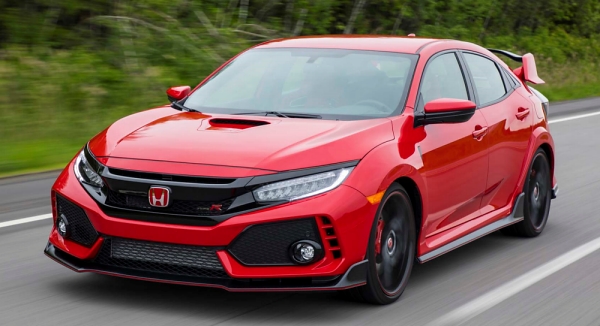 |
|
Above
150 mph, the positive downforce makes it remarkably stable.
|
|
In fact, like all its new Civic siblings the Type R is a lot more
refined and comfortable to use as an everyday transport. Its suspension
is no longer harsh, especially when you switch to the newly added
Comfort mode (beside the default Sport and ultimate R+). Sport mode is
not quite as smooth as Golf R or Leon Cupra, but more composed than a
Focus RS. R+ mode is still reserved for tracks or smooth A-roads, but
it is again an improvement from the old one. Noise level is much lower.
On highway the exhaust no longer booms. The cabin is also a much nicer
place. You sit 50mm lower than before in a spot-on driving position and
face easy-reading instruments finally. The heavily bolstered red bucket
seats (a tradition of Type R) are manually adjustable but supportive
and comfortable.
As usual, the Type R’s steering is not famous for feel, but it is quick
and precise enough to give you confidence. The new car attacks corners
with impressive stability and composure, no doubt helped by the longer
wheelbase and more sophisticated rear suspension. Despite the lack of
4WD, the front axle puts down the power well thanks to the use of a
helical LSD. There is precious little torque steer even under push in
tight corners. The Continental tires offer good grip, if not as
exceptional as its rivals fitted with Michelin PS Cup2 (Golf Clubsport
S or the old Megane RS275 Trophy R). On track, it generates a little
understeer at corner entry, so it prefers conventional slow-in,
fast-out technique to guide. Lift off mid-corner could induce a hint of
oversteer, but it is more subtle than the Megane RS. Being slightly
more agile and more interactive than the Golf R, it is also slightly
more entertaining to drive. However, on a B-road the more compact
Volkswagen is hardly any less agile, and its 4-wheel-drive security
compensates. Meanwhile, Ford Focus RS is more entertaining still if you
like to play drift. It also comes with a better steering. What these
cars can’t match the Civic is high-speed stability. Above 150 mph, the
positive downforce makes it remarkably stable.
That is also why the Type R could excel in Nurburgring. It tops the
class again with a new lap record of 7:43.8, or 5.4 seconds faster than
the last record holder Golf Clubsport S. That title matches its
race-car look very well and should leave the German chasing hard for
some years.
|
Verdict:      |
|